Zara: Strategic Analysis of Zara's Corporate Strategy - Report
VerifiedAdded on 2023/01/12
|11
|2916
|96
Report
AI Summary
This report provides a comprehensive strategic analysis of Zara, a leading fashion retailer. It begins with an introduction to corporate strategy and its importance for companies like Zara. The main body of the report comprises an in-depth examination of Zara's external environment using PESTLE and Porter's Five Forces analyses, identifying political, economic, social, technological, legal, and environmental factors, as well as competitive dynamics. The internal environment is then assessed through SWOT and VRIO analyses, highlighting Zara's strengths, weaknesses, opportunities, and threats, along with the value, rareness, imitability, and organization of its resources. Finally, the report evaluates Zara's recent implementation of RFID technology in its stores using the SAF (Suitability, Acceptability, Feasibility) evaluation model, determining the strategy's alignment with organizational objectives, stakeholder acceptance, and practical viability. The conclusion summarizes the key findings and implications of the analysis.
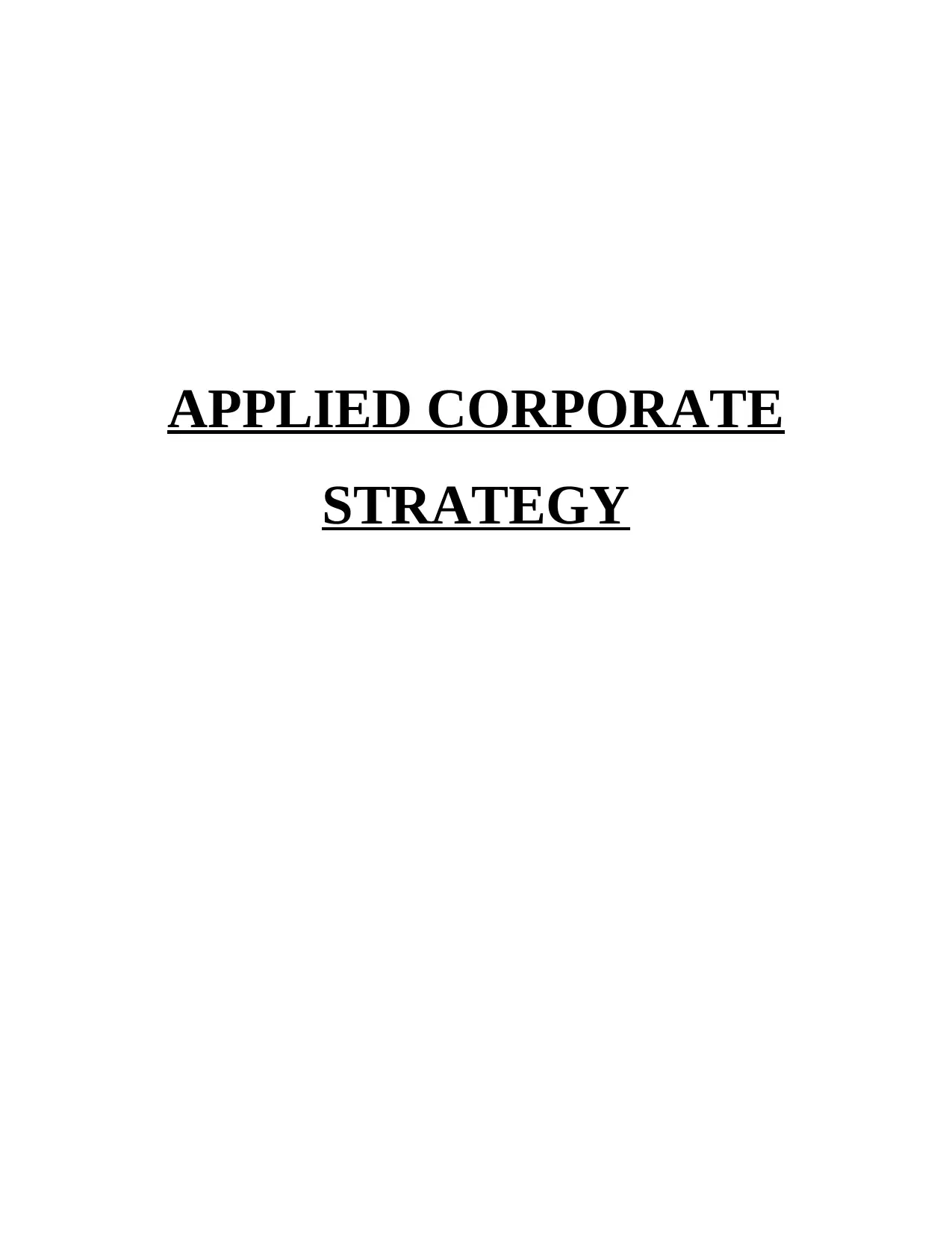
APPLIED CORPORATE
STRATEGY
STRATEGY
Paraphrase This Document
Need a fresh take? Get an instant paraphrase of this document with our AI Paraphraser
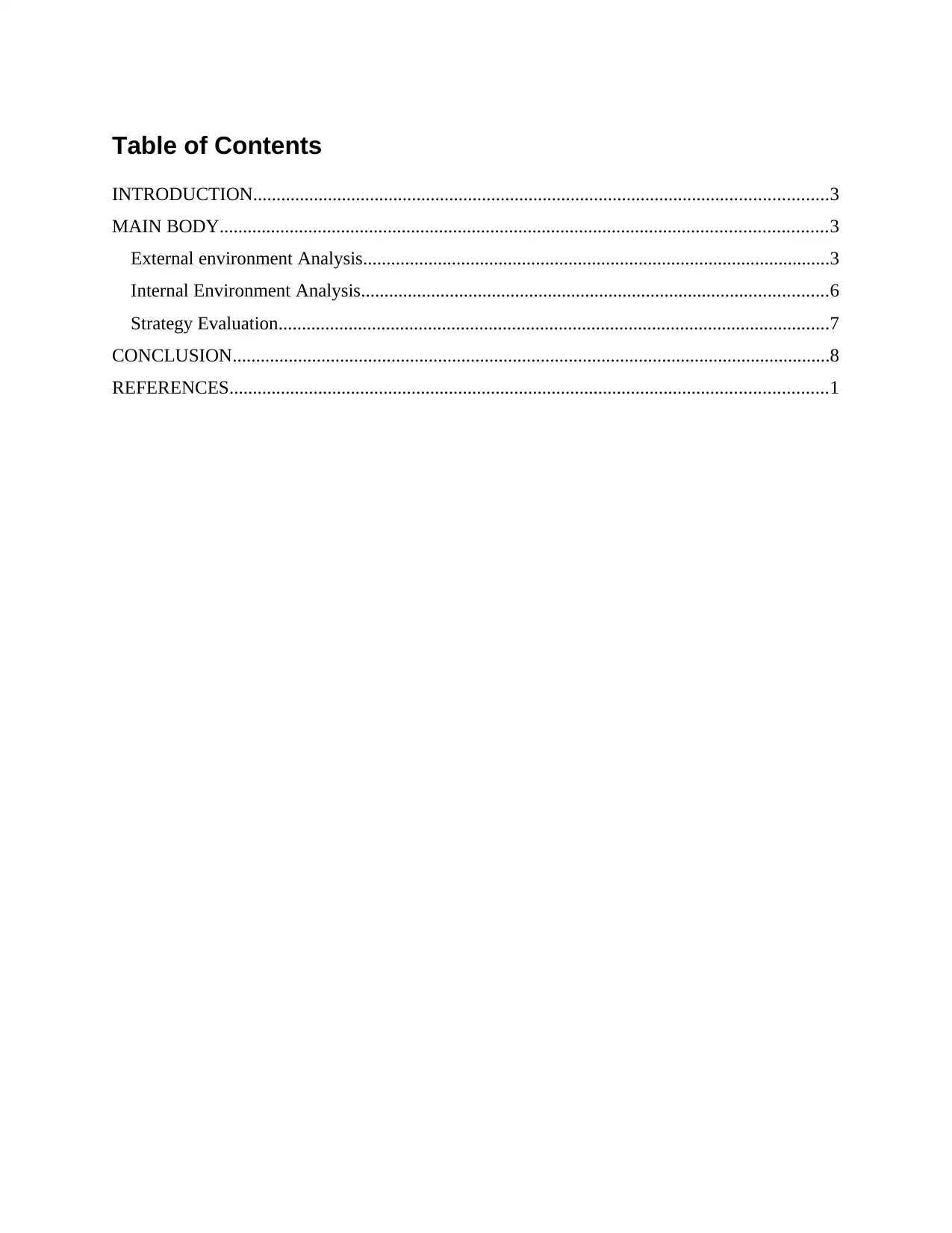
Table of Contents
INTRODUCTION...........................................................................................................................3
MAIN BODY..................................................................................................................................3
External environment Analysis....................................................................................................3
Internal Environment Analysis....................................................................................................6
Strategy Evaluation......................................................................................................................7
CONCLUSION................................................................................................................................8
REFERENCES................................................................................................................................1
INTRODUCTION...........................................................................................................................3
MAIN BODY..................................................................................................................................3
External environment Analysis....................................................................................................3
Internal Environment Analysis....................................................................................................6
Strategy Evaluation......................................................................................................................7
CONCLUSION................................................................................................................................8
REFERENCES................................................................................................................................1
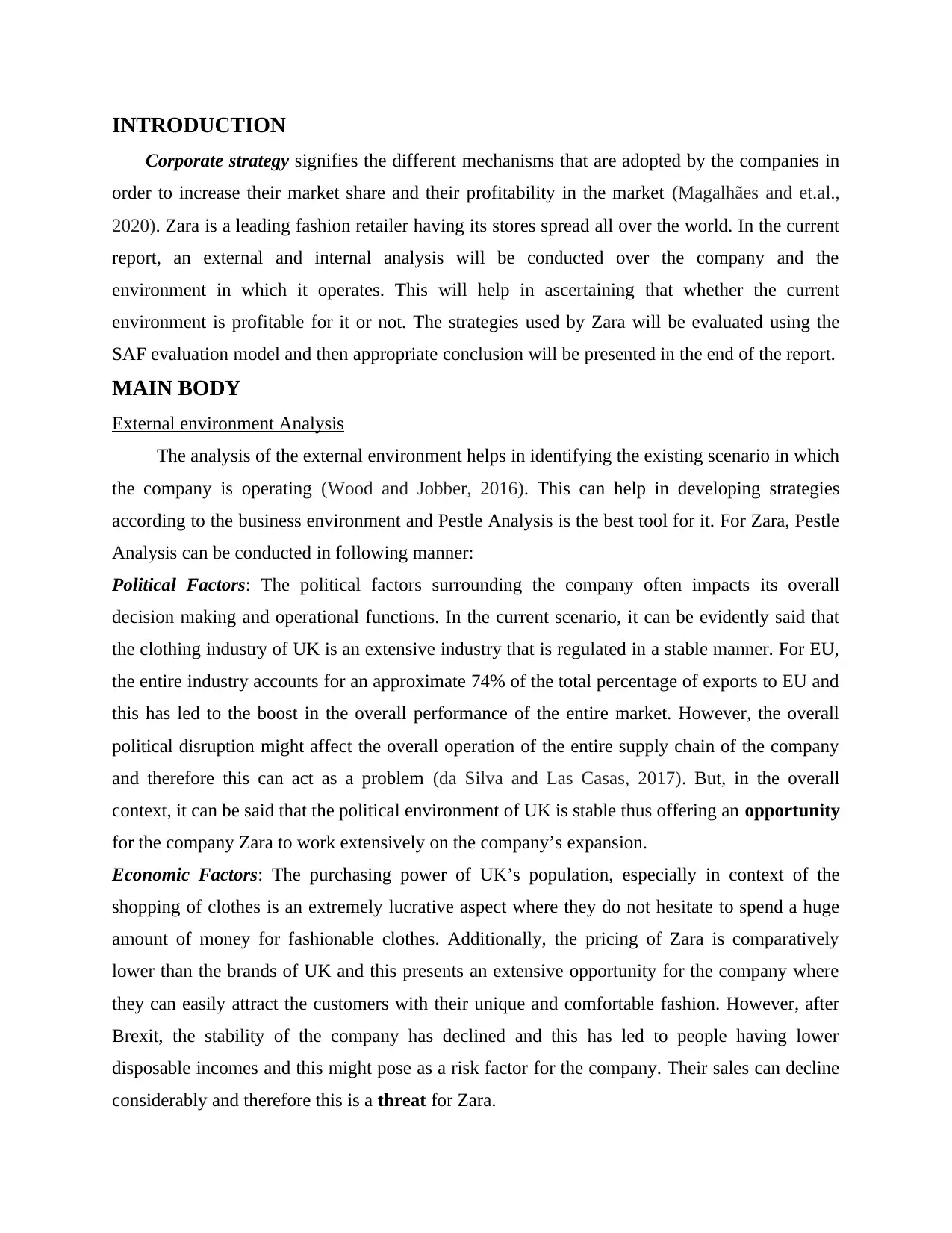
INTRODUCTION
Corporate strategy signifies the different mechanisms that are adopted by the companies in
order to increase their market share and their profitability in the market (Magalhães and et.al.,
2020). Zara is a leading fashion retailer having its stores spread all over the world. In the current
report, an external and internal analysis will be conducted over the company and the
environment in which it operates. This will help in ascertaining that whether the current
environment is profitable for it or not. The strategies used by Zara will be evaluated using the
SAF evaluation model and then appropriate conclusion will be presented in the end of the report.
MAIN BODY
External environment Analysis
The analysis of the external environment helps in identifying the existing scenario in which
the company is operating (Wood and Jobber, 2016). This can help in developing strategies
according to the business environment and Pestle Analysis is the best tool for it. For Zara, Pestle
Analysis can be conducted in following manner:
Political Factors: The political factors surrounding the company often impacts its overall
decision making and operational functions. In the current scenario, it can be evidently said that
the clothing industry of UK is an extensive industry that is regulated in a stable manner. For EU,
the entire industry accounts for an approximate 74% of the total percentage of exports to EU and
this has led to the boost in the overall performance of the entire market. However, the overall
political disruption might affect the overall operation of the entire supply chain of the company
and therefore this can act as a problem (da Silva and Las Casas, 2017). But, in the overall
context, it can be said that the political environment of UK is stable thus offering an opportunity
for the company Zara to work extensively on the company’s expansion.
Economic Factors: The purchasing power of UK’s population, especially in context of the
shopping of clothes is an extremely lucrative aspect where they do not hesitate to spend a huge
amount of money for fashionable clothes. Additionally, the pricing of Zara is comparatively
lower than the brands of UK and this presents an extensive opportunity for the company where
they can easily attract the customers with their unique and comfortable fashion. However, after
Brexit, the stability of the company has declined and this has led to people having lower
disposable incomes and this might pose as a risk factor for the company. Their sales can decline
considerably and therefore this is a threat for Zara.
Corporate strategy signifies the different mechanisms that are adopted by the companies in
order to increase their market share and their profitability in the market (Magalhães and et.al.,
2020). Zara is a leading fashion retailer having its stores spread all over the world. In the current
report, an external and internal analysis will be conducted over the company and the
environment in which it operates. This will help in ascertaining that whether the current
environment is profitable for it or not. The strategies used by Zara will be evaluated using the
SAF evaluation model and then appropriate conclusion will be presented in the end of the report.
MAIN BODY
External environment Analysis
The analysis of the external environment helps in identifying the existing scenario in which
the company is operating (Wood and Jobber, 2016). This can help in developing strategies
according to the business environment and Pestle Analysis is the best tool for it. For Zara, Pestle
Analysis can be conducted in following manner:
Political Factors: The political factors surrounding the company often impacts its overall
decision making and operational functions. In the current scenario, it can be evidently said that
the clothing industry of UK is an extensive industry that is regulated in a stable manner. For EU,
the entire industry accounts for an approximate 74% of the total percentage of exports to EU and
this has led to the boost in the overall performance of the entire market. However, the overall
political disruption might affect the overall operation of the entire supply chain of the company
and therefore this can act as a problem (da Silva and Las Casas, 2017). But, in the overall
context, it can be said that the political environment of UK is stable thus offering an opportunity
for the company Zara to work extensively on the company’s expansion.
Economic Factors: The purchasing power of UK’s population, especially in context of the
shopping of clothes is an extremely lucrative aspect where they do not hesitate to spend a huge
amount of money for fashionable clothes. Additionally, the pricing of Zara is comparatively
lower than the brands of UK and this presents an extensive opportunity for the company where
they can easily attract the customers with their unique and comfortable fashion. However, after
Brexit, the stability of the company has declined and this has led to people having lower
disposable incomes and this might pose as a risk factor for the company. Their sales can decline
considerably and therefore this is a threat for Zara.
⊘ This is a preview!⊘
Do you want full access?
Subscribe today to unlock all pages.

Trusted by 1+ million students worldwide
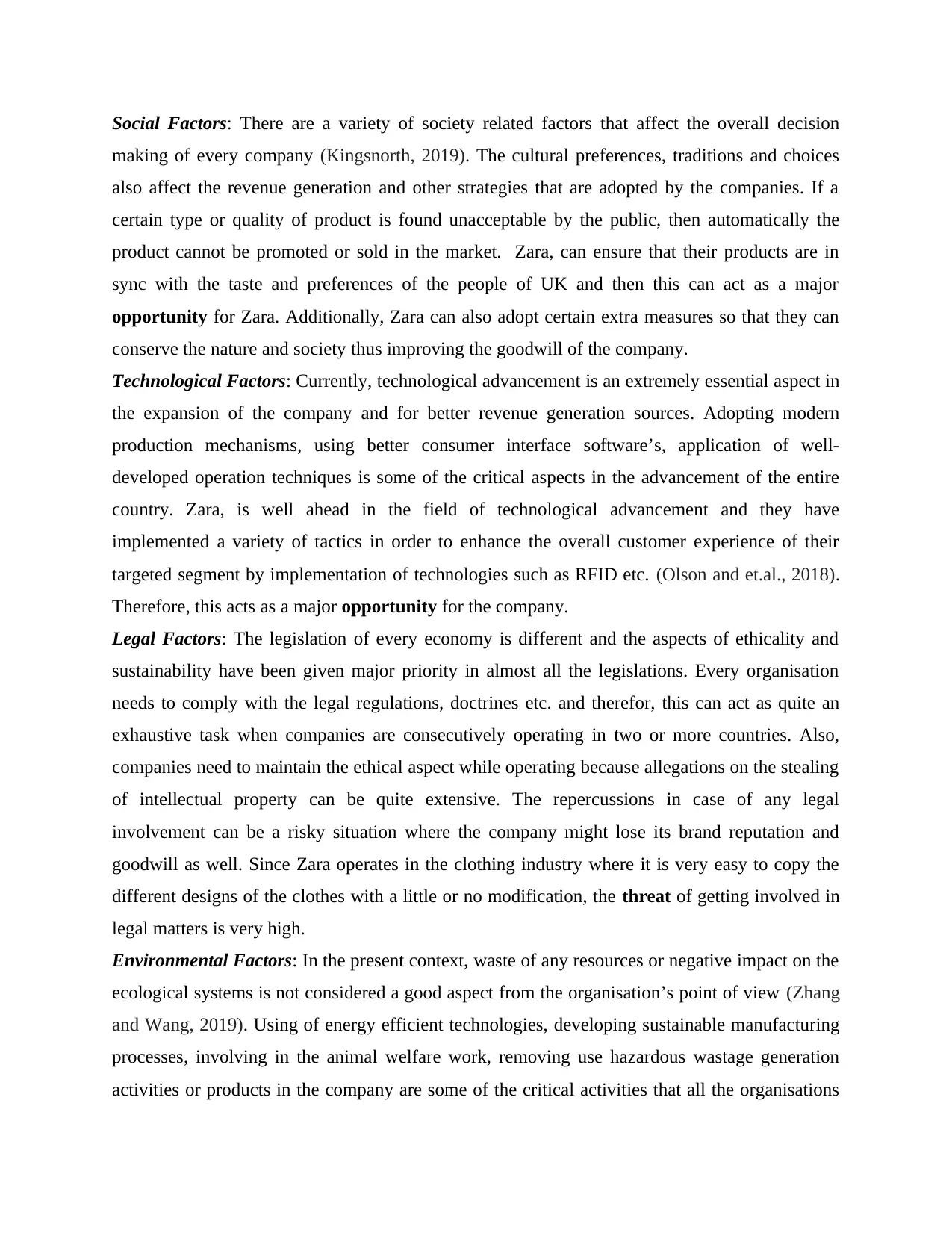
Social Factors: There are a variety of society related factors that affect the overall decision
making of every company (Kingsnorth, 2019). The cultural preferences, traditions and choices
also affect the revenue generation and other strategies that are adopted by the companies. If a
certain type or quality of product is found unacceptable by the public, then automatically the
product cannot be promoted or sold in the market. Zara, can ensure that their products are in
sync with the taste and preferences of the people of UK and then this can act as a major
opportunity for Zara. Additionally, Zara can also adopt certain extra measures so that they can
conserve the nature and society thus improving the goodwill of the company.
Technological Factors: Currently, technological advancement is an extremely essential aspect in
the expansion of the company and for better revenue generation sources. Adopting modern
production mechanisms, using better consumer interface software’s, application of well-
developed operation techniques is some of the critical aspects in the advancement of the entire
country. Zara, is well ahead in the field of technological advancement and they have
implemented a variety of tactics in order to enhance the overall customer experience of their
targeted segment by implementation of technologies such as RFID etc. (Olson and et.al., 2018).
Therefore, this acts as a major opportunity for the company.
Legal Factors: The legislation of every economy is different and the aspects of ethicality and
sustainability have been given major priority in almost all the legislations. Every organisation
needs to comply with the legal regulations, doctrines etc. and therefor, this can act as quite an
exhaustive task when companies are consecutively operating in two or more countries. Also,
companies need to maintain the ethical aspect while operating because allegations on the stealing
of intellectual property can be quite extensive. The repercussions in case of any legal
involvement can be a risky situation where the company might lose its brand reputation and
goodwill as well. Since Zara operates in the clothing industry where it is very easy to copy the
different designs of the clothes with a little or no modification, the threat of getting involved in
legal matters is very high.
Environmental Factors: In the present context, waste of any resources or negative impact on the
ecological systems is not considered a good aspect from the organisation’s point of view (Zhang
and Wang, 2019). Using of energy efficient technologies, developing sustainable manufacturing
processes, involving in the animal welfare work, removing use hazardous wastage generation
activities or products in the company are some of the critical activities that all the organisations
making of every company (Kingsnorth, 2019). The cultural preferences, traditions and choices
also affect the revenue generation and other strategies that are adopted by the companies. If a
certain type or quality of product is found unacceptable by the public, then automatically the
product cannot be promoted or sold in the market. Zara, can ensure that their products are in
sync with the taste and preferences of the people of UK and then this can act as a major
opportunity for Zara. Additionally, Zara can also adopt certain extra measures so that they can
conserve the nature and society thus improving the goodwill of the company.
Technological Factors: Currently, technological advancement is an extremely essential aspect in
the expansion of the company and for better revenue generation sources. Adopting modern
production mechanisms, using better consumer interface software’s, application of well-
developed operation techniques is some of the critical aspects in the advancement of the entire
country. Zara, is well ahead in the field of technological advancement and they have
implemented a variety of tactics in order to enhance the overall customer experience of their
targeted segment by implementation of technologies such as RFID etc. (Olson and et.al., 2018).
Therefore, this acts as a major opportunity for the company.
Legal Factors: The legislation of every economy is different and the aspects of ethicality and
sustainability have been given major priority in almost all the legislations. Every organisation
needs to comply with the legal regulations, doctrines etc. and therefor, this can act as quite an
exhaustive task when companies are consecutively operating in two or more countries. Also,
companies need to maintain the ethical aspect while operating because allegations on the stealing
of intellectual property can be quite extensive. The repercussions in case of any legal
involvement can be a risky situation where the company might lose its brand reputation and
goodwill as well. Since Zara operates in the clothing industry where it is very easy to copy the
different designs of the clothes with a little or no modification, the threat of getting involved in
legal matters is very high.
Environmental Factors: In the present context, waste of any resources or negative impact on the
ecological systems is not considered a good aspect from the organisation’s point of view (Zhang
and Wang, 2019). Using of energy efficient technologies, developing sustainable manufacturing
processes, involving in the animal welfare work, removing use hazardous wastage generation
activities or products in the company are some of the critical activities that all the organisations
Paraphrase This Document
Need a fresh take? Get an instant paraphrase of this document with our AI Paraphraser
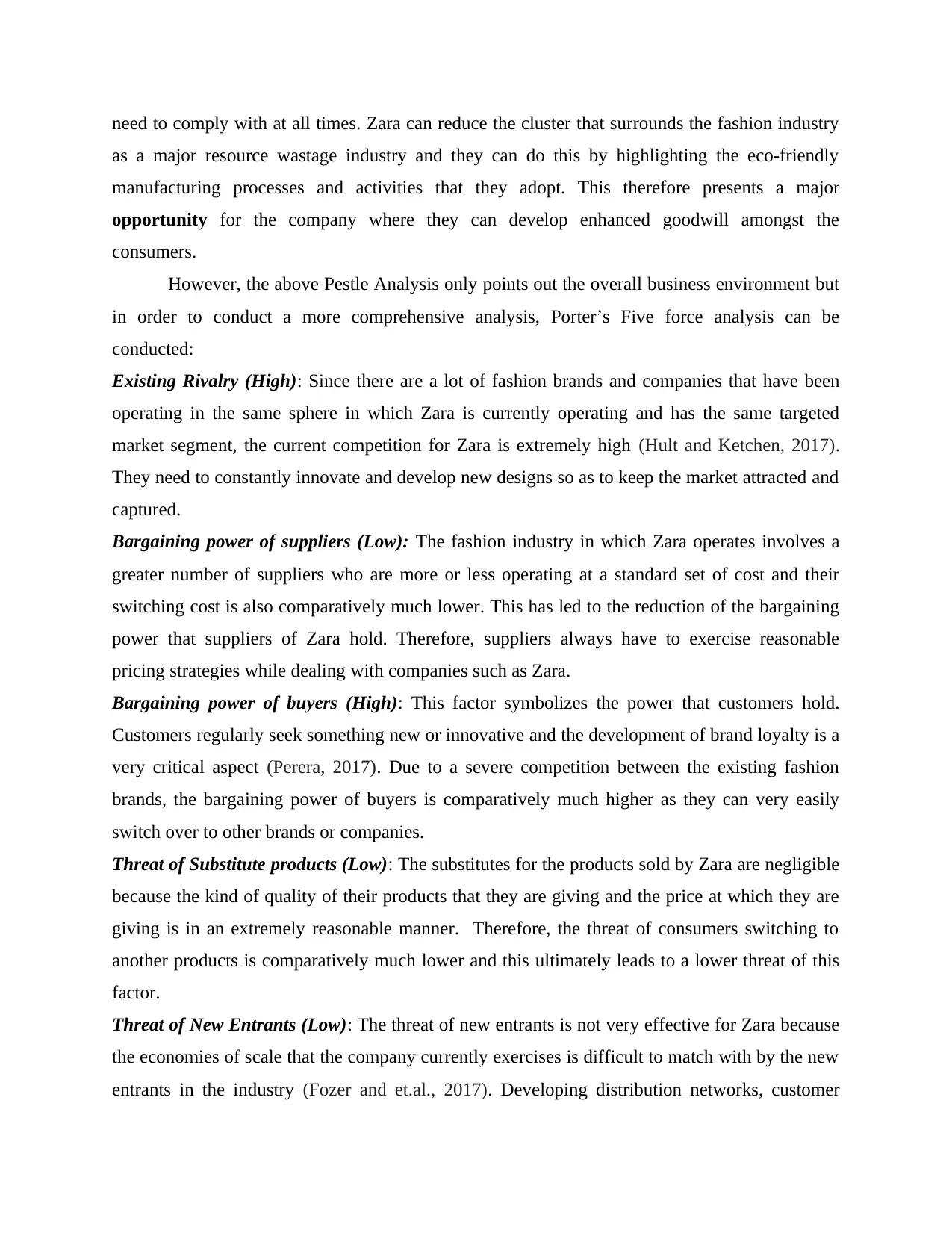
need to comply with at all times. Zara can reduce the cluster that surrounds the fashion industry
as a major resource wastage industry and they can do this by highlighting the eco-friendly
manufacturing processes and activities that they adopt. This therefore presents a major
opportunity for the company where they can develop enhanced goodwill amongst the
consumers.
However, the above Pestle Analysis only points out the overall business environment but
in order to conduct a more comprehensive analysis, Porter’s Five force analysis can be
conducted:
Existing Rivalry (High): Since there are a lot of fashion brands and companies that have been
operating in the same sphere in which Zara is currently operating and has the same targeted
market segment, the current competition for Zara is extremely high (Hult and Ketchen, 2017).
They need to constantly innovate and develop new designs so as to keep the market attracted and
captured.
Bargaining power of suppliers (Low): The fashion industry in which Zara operates involves a
greater number of suppliers who are more or less operating at a standard set of cost and their
switching cost is also comparatively much lower. This has led to the reduction of the bargaining
power that suppliers of Zara hold. Therefore, suppliers always have to exercise reasonable
pricing strategies while dealing with companies such as Zara.
Bargaining power of buyers (High): This factor symbolizes the power that customers hold.
Customers regularly seek something new or innovative and the development of brand loyalty is a
very critical aspect (Perera, 2017). Due to a severe competition between the existing fashion
brands, the bargaining power of buyers is comparatively much higher as they can very easily
switch over to other brands or companies.
Threat of Substitute products (Low): The substitutes for the products sold by Zara are negligible
because the kind of quality of their products that they are giving and the price at which they are
giving is in an extremely reasonable manner. Therefore, the threat of consumers switching to
another products is comparatively much lower and this ultimately leads to a lower threat of this
factor.
Threat of New Entrants (Low): The threat of new entrants is not very effective for Zara because
the economies of scale that the company currently exercises is difficult to match with by the new
entrants in the industry (Fozer and et.al., 2017). Developing distribution networks, customer
as a major resource wastage industry and they can do this by highlighting the eco-friendly
manufacturing processes and activities that they adopt. This therefore presents a major
opportunity for the company where they can develop enhanced goodwill amongst the
consumers.
However, the above Pestle Analysis only points out the overall business environment but
in order to conduct a more comprehensive analysis, Porter’s Five force analysis can be
conducted:
Existing Rivalry (High): Since there are a lot of fashion brands and companies that have been
operating in the same sphere in which Zara is currently operating and has the same targeted
market segment, the current competition for Zara is extremely high (Hult and Ketchen, 2017).
They need to constantly innovate and develop new designs so as to keep the market attracted and
captured.
Bargaining power of suppliers (Low): The fashion industry in which Zara operates involves a
greater number of suppliers who are more or less operating at a standard set of cost and their
switching cost is also comparatively much lower. This has led to the reduction of the bargaining
power that suppliers of Zara hold. Therefore, suppliers always have to exercise reasonable
pricing strategies while dealing with companies such as Zara.
Bargaining power of buyers (High): This factor symbolizes the power that customers hold.
Customers regularly seek something new or innovative and the development of brand loyalty is a
very critical aspect (Perera, 2017). Due to a severe competition between the existing fashion
brands, the bargaining power of buyers is comparatively much higher as they can very easily
switch over to other brands or companies.
Threat of Substitute products (Low): The substitutes for the products sold by Zara are negligible
because the kind of quality of their products that they are giving and the price at which they are
giving is in an extremely reasonable manner. Therefore, the threat of consumers switching to
another products is comparatively much lower and this ultimately leads to a lower threat of this
factor.
Threat of New Entrants (Low): The threat of new entrants is not very effective for Zara because
the economies of scale that the company currently exercises is difficult to match with by the new
entrants in the industry (Fozer and et.al., 2017). Developing distribution networks, customer
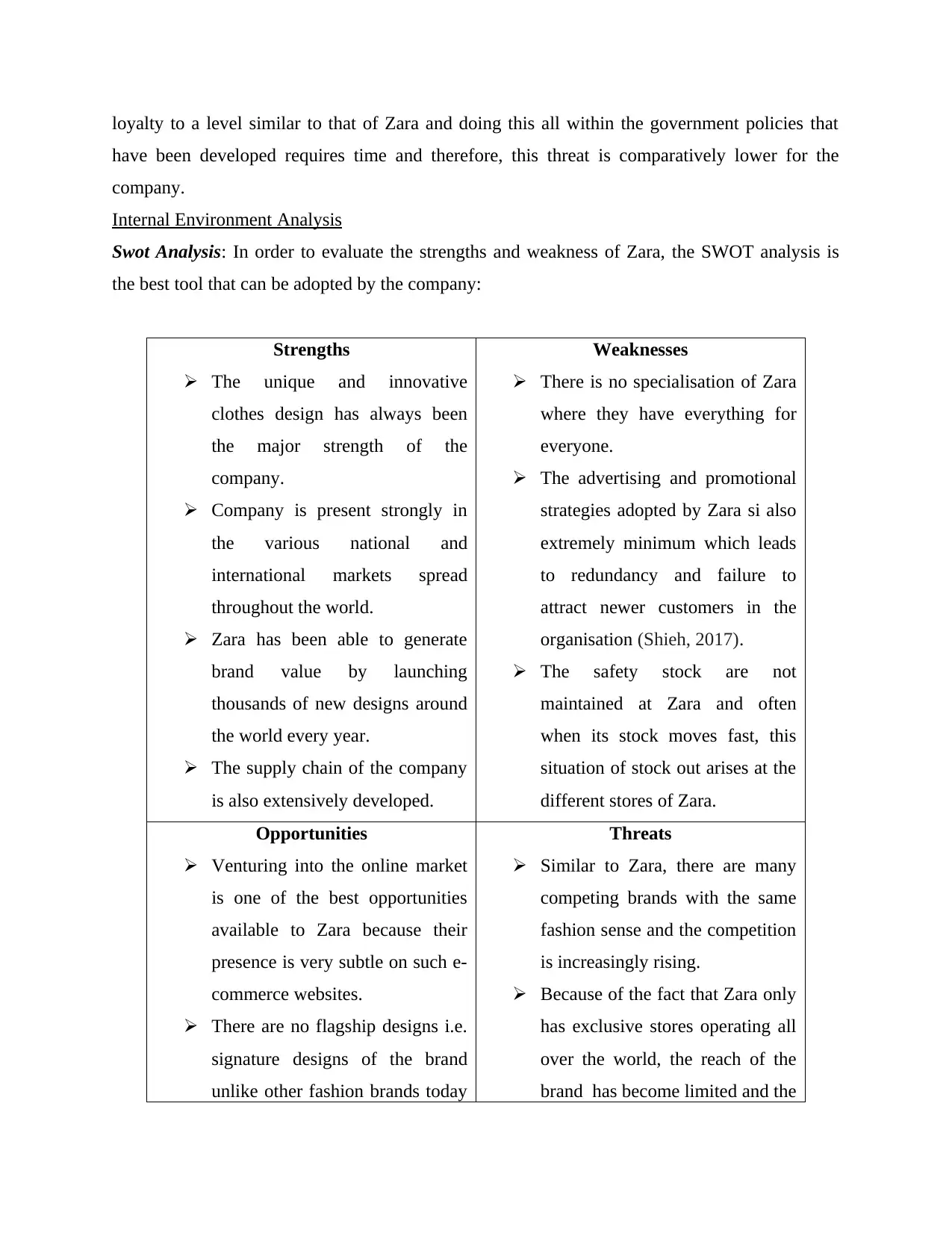
loyalty to a level similar to that of Zara and doing this all within the government policies that
have been developed requires time and therefore, this threat is comparatively lower for the
company.
Internal Environment Analysis
Swot Analysis: In order to evaluate the strengths and weakness of Zara, the SWOT analysis is
the best tool that can be adopted by the company:
Strengths
The unique and innovative
clothes design has always been
the major strength of the
company.
Company is present strongly in
the various national and
international markets spread
throughout the world.
Zara has been able to generate
brand value by launching
thousands of new designs around
the world every year.
The supply chain of the company
is also extensively developed.
Weaknesses
There is no specialisation of Zara
where they have everything for
everyone.
The advertising and promotional
strategies adopted by Zara si also
extremely minimum which leads
to redundancy and failure to
attract newer customers in the
organisation (Shieh, 2017).
The safety stock are not
maintained at Zara and often
when its stock moves fast, this
situation of stock out arises at the
different stores of Zara.
Opportunities
Venturing into the online market
is one of the best opportunities
available to Zara because their
presence is very subtle on such e-
commerce websites.
There are no flagship designs i.e.
signature designs of the brand
unlike other fashion brands today
Threats
Similar to Zara, there are many
competing brands with the same
fashion sense and the competition
is increasingly rising.
Because of the fact that Zara only
has exclusive stores operating all
over the world, the reach of the
brand has become limited and the
have been developed requires time and therefore, this threat is comparatively lower for the
company.
Internal Environment Analysis
Swot Analysis: In order to evaluate the strengths and weakness of Zara, the SWOT analysis is
the best tool that can be adopted by the company:
Strengths
The unique and innovative
clothes design has always been
the major strength of the
company.
Company is present strongly in
the various national and
international markets spread
throughout the world.
Zara has been able to generate
brand value by launching
thousands of new designs around
the world every year.
The supply chain of the company
is also extensively developed.
Weaknesses
There is no specialisation of Zara
where they have everything for
everyone.
The advertising and promotional
strategies adopted by Zara si also
extremely minimum which leads
to redundancy and failure to
attract newer customers in the
organisation (Shieh, 2017).
The safety stock are not
maintained at Zara and often
when its stock moves fast, this
situation of stock out arises at the
different stores of Zara.
Opportunities
Venturing into the online market
is one of the best opportunities
available to Zara because their
presence is very subtle on such e-
commerce websites.
There are no flagship designs i.e.
signature designs of the brand
unlike other fashion brands today
Threats
Similar to Zara, there are many
competing brands with the same
fashion sense and the competition
is increasingly rising.
Because of the fact that Zara only
has exclusive stores operating all
over the world, the reach of the
brand has become limited and the
⊘ This is a preview!⊘
Do you want full access?
Subscribe today to unlock all pages.

Trusted by 1+ million students worldwide
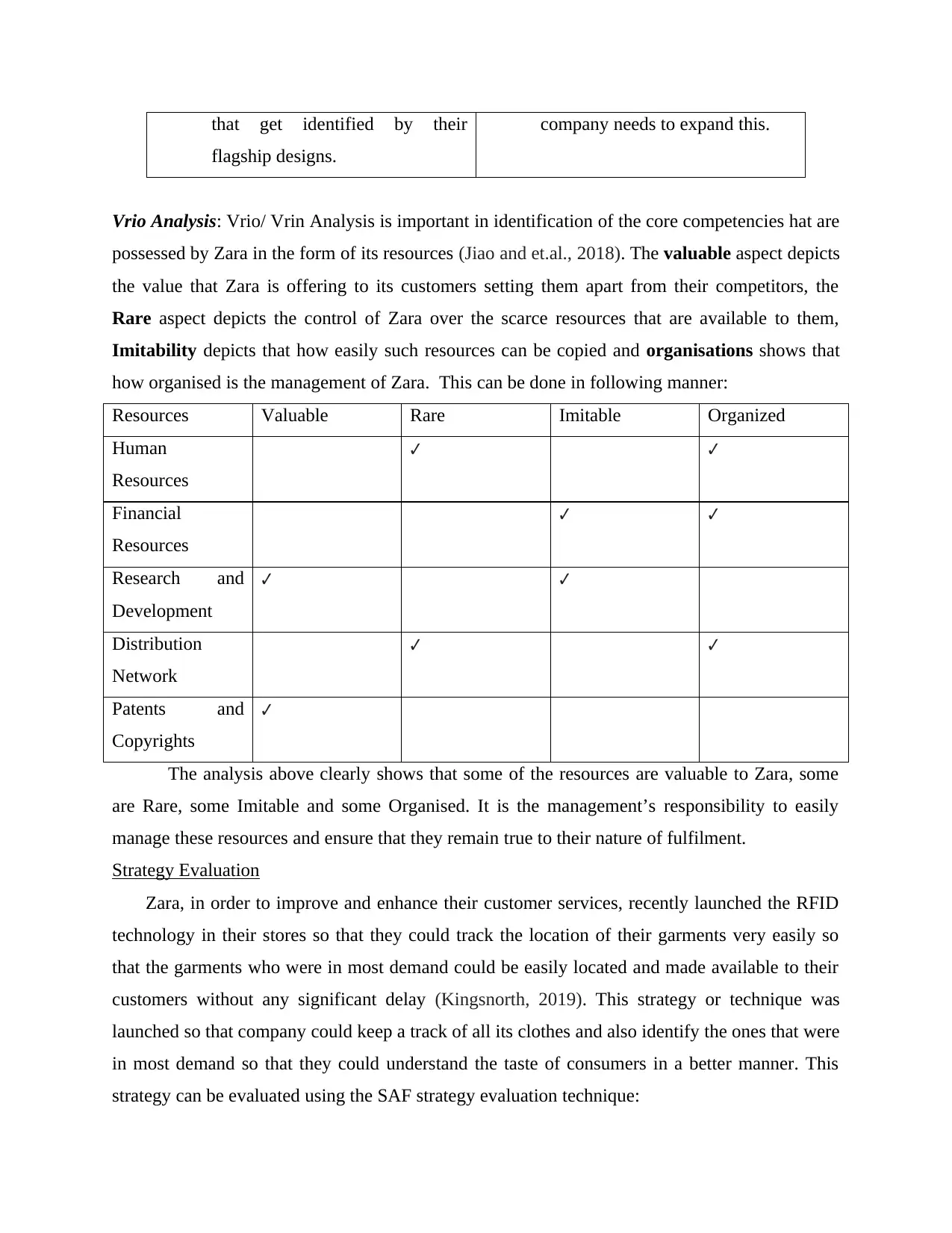
that get identified by their
flagship designs.
company needs to expand this.
Vrio Analysis: Vrio/ Vrin Analysis is important in identification of the core competencies hat are
possessed by Zara in the form of its resources (Jiao and et.al., 2018). The valuable aspect depicts
the value that Zara is offering to its customers setting them apart from their competitors, the
Rare aspect depicts the control of Zara over the scarce resources that are available to them,
Imitability depicts that how easily such resources can be copied and organisations shows that
how organised is the management of Zara. This can be done in following manner:
Resources Valuable Rare Imitable Organized
Human
Resources
✔ ✔
Financial
Resources
✔ ✔
Research and
Development
✔ ✔
Distribution
Network
✔ ✔
Patents and
Copyrights
✔
The analysis above clearly shows that some of the resources are valuable to Zara, some
are Rare, some Imitable and some Organised. It is the management’s responsibility to easily
manage these resources and ensure that they remain true to their nature of fulfilment.
Strategy Evaluation
Zara, in order to improve and enhance their customer services, recently launched the RFID
technology in their stores so that they could track the location of their garments very easily so
that the garments who were in most demand could be easily located and made available to their
customers without any significant delay (Kingsnorth, 2019). This strategy or technique was
launched so that company could keep a track of all its clothes and also identify the ones that were
in most demand so that they could understand the taste of consumers in a better manner. This
strategy can be evaluated using the SAF strategy evaluation technique:
flagship designs.
company needs to expand this.
Vrio Analysis: Vrio/ Vrin Analysis is important in identification of the core competencies hat are
possessed by Zara in the form of its resources (Jiao and et.al., 2018). The valuable aspect depicts
the value that Zara is offering to its customers setting them apart from their competitors, the
Rare aspect depicts the control of Zara over the scarce resources that are available to them,
Imitability depicts that how easily such resources can be copied and organisations shows that
how organised is the management of Zara. This can be done in following manner:
Resources Valuable Rare Imitable Organized
Human
Resources
✔ ✔
Financial
Resources
✔ ✔
Research and
Development
✔ ✔
Distribution
Network
✔ ✔
Patents and
Copyrights
✔
The analysis above clearly shows that some of the resources are valuable to Zara, some
are Rare, some Imitable and some Organised. It is the management’s responsibility to easily
manage these resources and ensure that they remain true to their nature of fulfilment.
Strategy Evaluation
Zara, in order to improve and enhance their customer services, recently launched the RFID
technology in their stores so that they could track the location of their garments very easily so
that the garments who were in most demand could be easily located and made available to their
customers without any significant delay (Kingsnorth, 2019). This strategy or technique was
launched so that company could keep a track of all its clothes and also identify the ones that were
in most demand so that they could understand the taste of consumers in a better manner. This
strategy can be evaluated using the SAF strategy evaluation technique:
Paraphrase This Document
Need a fresh take? Get an instant paraphrase of this document with our AI Paraphraser
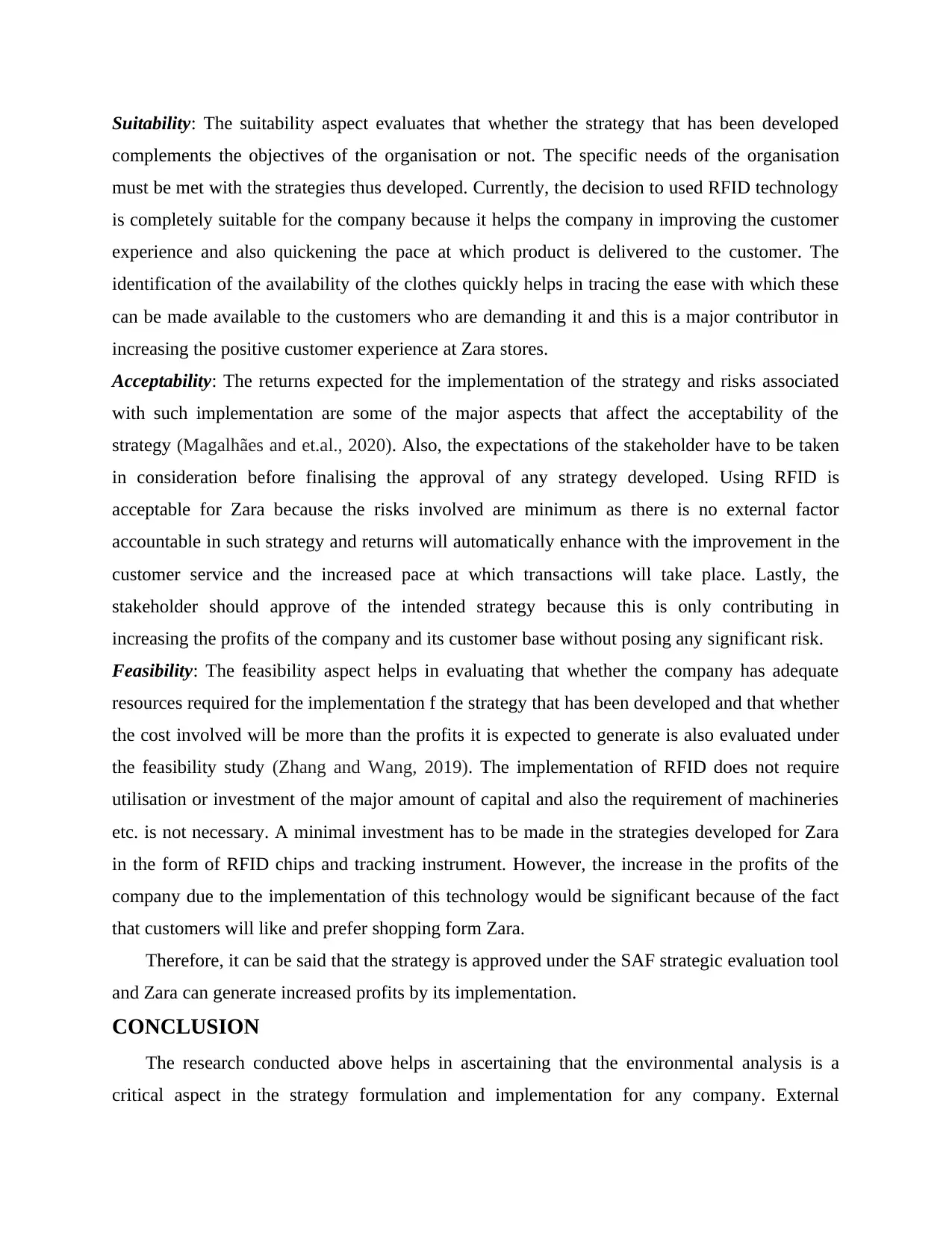
Suitability: The suitability aspect evaluates that whether the strategy that has been developed
complements the objectives of the organisation or not. The specific needs of the organisation
must be met with the strategies thus developed. Currently, the decision to used RFID technology
is completely suitable for the company because it helps the company in improving the customer
experience and also quickening the pace at which product is delivered to the customer. The
identification of the availability of the clothes quickly helps in tracing the ease with which these
can be made available to the customers who are demanding it and this is a major contributor in
increasing the positive customer experience at Zara stores.
Acceptability: The returns expected for the implementation of the strategy and risks associated
with such implementation are some of the major aspects that affect the acceptability of the
strategy (Magalhães and et.al., 2020). Also, the expectations of the stakeholder have to be taken
in consideration before finalising the approval of any strategy developed. Using RFID is
acceptable for Zara because the risks involved are minimum as there is no external factor
accountable in such strategy and returns will automatically enhance with the improvement in the
customer service and the increased pace at which transactions will take place. Lastly, the
stakeholder should approve of the intended strategy because this is only contributing in
increasing the profits of the company and its customer base without posing any significant risk.
Feasibility: The feasibility aspect helps in evaluating that whether the company has adequate
resources required for the implementation f the strategy that has been developed and that whether
the cost involved will be more than the profits it is expected to generate is also evaluated under
the feasibility study (Zhang and Wang, 2019). The implementation of RFID does not require
utilisation or investment of the major amount of capital and also the requirement of machineries
etc. is not necessary. A minimal investment has to be made in the strategies developed for Zara
in the form of RFID chips and tracking instrument. However, the increase in the profits of the
company due to the implementation of this technology would be significant because of the fact
that customers will like and prefer shopping form Zara.
Therefore, it can be said that the strategy is approved under the SAF strategic evaluation tool
and Zara can generate increased profits by its implementation.
CONCLUSION
The research conducted above helps in ascertaining that the environmental analysis is a
critical aspect in the strategy formulation and implementation for any company. External
complements the objectives of the organisation or not. The specific needs of the organisation
must be met with the strategies thus developed. Currently, the decision to used RFID technology
is completely suitable for the company because it helps the company in improving the customer
experience and also quickening the pace at which product is delivered to the customer. The
identification of the availability of the clothes quickly helps in tracing the ease with which these
can be made available to the customers who are demanding it and this is a major contributor in
increasing the positive customer experience at Zara stores.
Acceptability: The returns expected for the implementation of the strategy and risks associated
with such implementation are some of the major aspects that affect the acceptability of the
strategy (Magalhães and et.al., 2020). Also, the expectations of the stakeholder have to be taken
in consideration before finalising the approval of any strategy developed. Using RFID is
acceptable for Zara because the risks involved are minimum as there is no external factor
accountable in such strategy and returns will automatically enhance with the improvement in the
customer service and the increased pace at which transactions will take place. Lastly, the
stakeholder should approve of the intended strategy because this is only contributing in
increasing the profits of the company and its customer base without posing any significant risk.
Feasibility: The feasibility aspect helps in evaluating that whether the company has adequate
resources required for the implementation f the strategy that has been developed and that whether
the cost involved will be more than the profits it is expected to generate is also evaluated under
the feasibility study (Zhang and Wang, 2019). The implementation of RFID does not require
utilisation or investment of the major amount of capital and also the requirement of machineries
etc. is not necessary. A minimal investment has to be made in the strategies developed for Zara
in the form of RFID chips and tracking instrument. However, the increase in the profits of the
company due to the implementation of this technology would be significant because of the fact
that customers will like and prefer shopping form Zara.
Therefore, it can be said that the strategy is approved under the SAF strategic evaluation tool
and Zara can generate increased profits by its implementation.
CONCLUSION
The research conducted above helps in ascertaining that the environmental analysis is a
critical aspect in the strategy formulation and implementation for any company. External
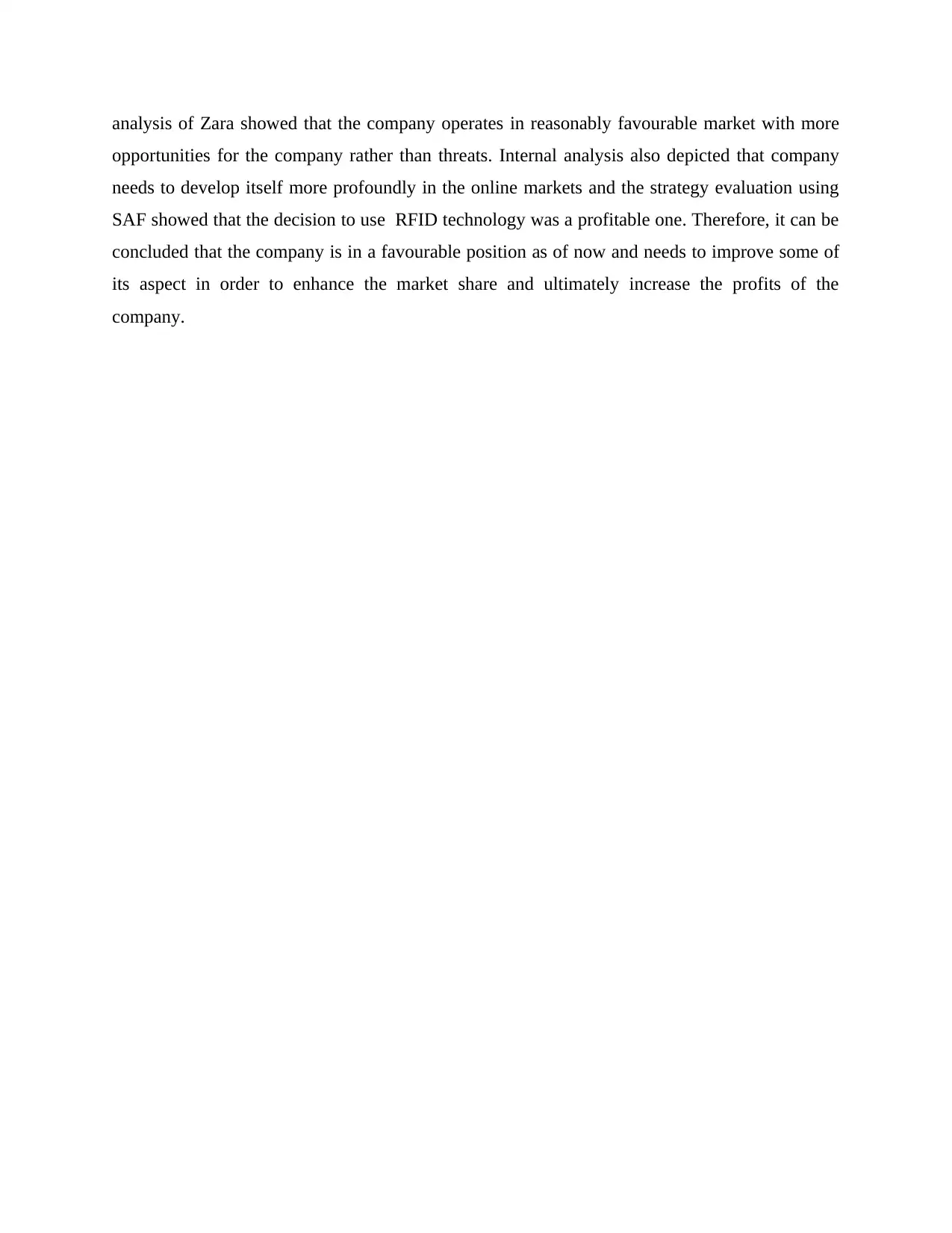
analysis of Zara showed that the company operates in reasonably favourable market with more
opportunities for the company rather than threats. Internal analysis also depicted that company
needs to develop itself more profoundly in the online markets and the strategy evaluation using
SAF showed that the decision to use RFID technology was a profitable one. Therefore, it can be
concluded that the company is in a favourable position as of now and needs to improve some of
its aspect in order to enhance the market share and ultimately increase the profits of the
company.
opportunities for the company rather than threats. Internal analysis also depicted that company
needs to develop itself more profoundly in the online markets and the strategy evaluation using
SAF showed that the decision to use RFID technology was a profitable one. Therefore, it can be
concluded that the company is in a favourable position as of now and needs to improve some of
its aspect in order to enhance the market share and ultimately increase the profits of the
company.
⊘ This is a preview!⊘
Do you want full access?
Subscribe today to unlock all pages.

Trusted by 1+ million students worldwide
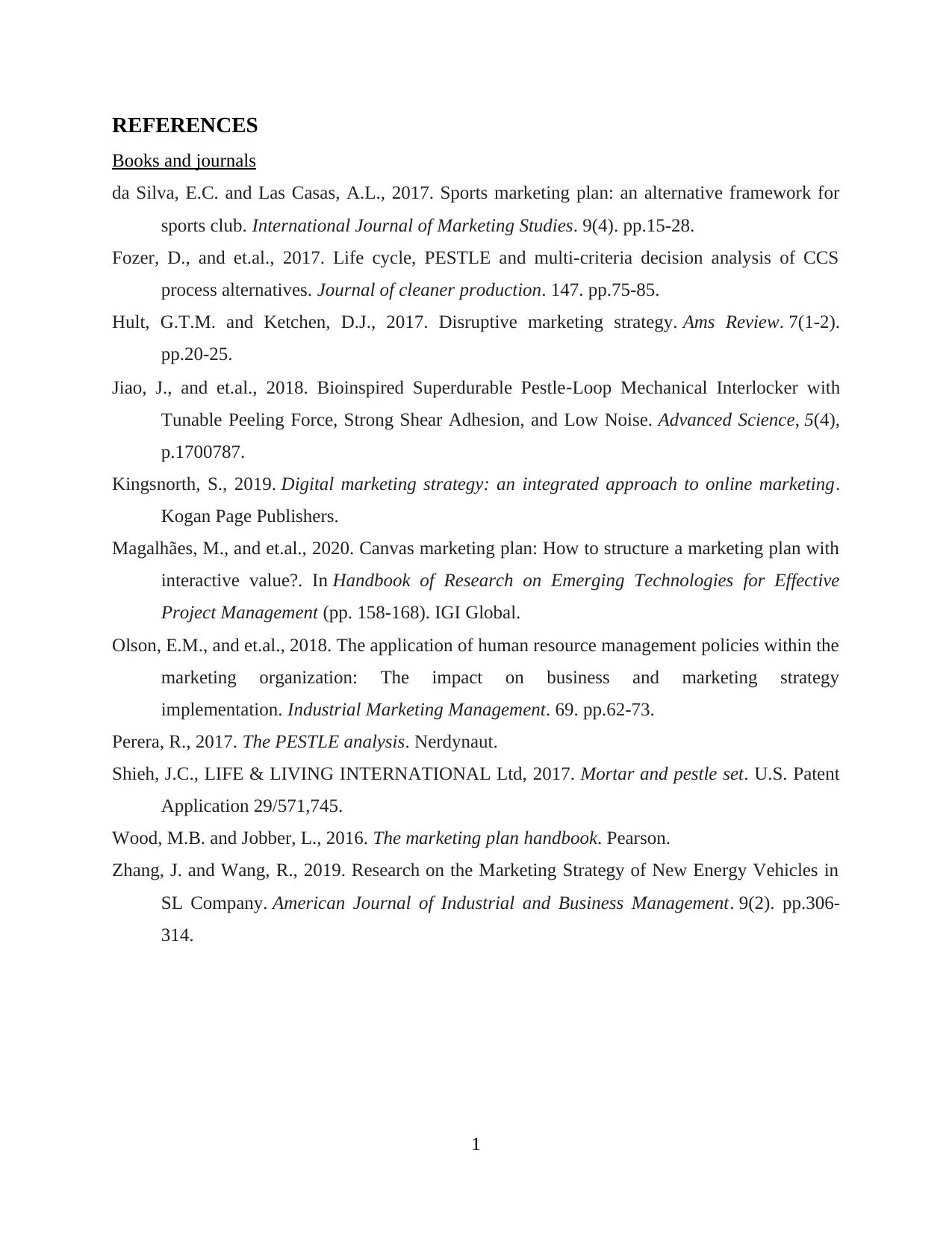
REFERENCES
Books and journals
da Silva, E.C. and Las Casas, A.L., 2017. Sports marketing plan: an alternative framework for
sports club. International Journal of Marketing Studies. 9(4). pp.15-28.
Fozer, D., and et.al., 2017. Life cycle, PESTLE and multi-criteria decision analysis of CCS
process alternatives. Journal of cleaner production. 147. pp.75-85.
Hult, G.T.M. and Ketchen, D.J., 2017. Disruptive marketing strategy. Ams Review. 7(1-2).
pp.20-25.
Jiao, J., and et.al., 2018. Bioinspired Superdurable Pestle‐Loop Mechanical Interlocker with
Tunable Peeling Force, Strong Shear Adhesion, and Low Noise. Advanced Science, 5(4),
p.1700787.
Kingsnorth, S., 2019. Digital marketing strategy: an integrated approach to online marketing.
Kogan Page Publishers.
Magalhães, M., and et.al., 2020. Canvas marketing plan: How to structure a marketing plan with
interactive value?. In Handbook of Research on Emerging Technologies for Effective
Project Management (pp. 158-168). IGI Global.
Olson, E.M., and et.al., 2018. The application of human resource management policies within the
marketing organization: The impact on business and marketing strategy
implementation. Industrial Marketing Management. 69. pp.62-73.
Perera, R., 2017. The PESTLE analysis. Nerdynaut.
Shieh, J.C., LIFE & LIVING INTERNATIONAL Ltd, 2017. Mortar and pestle set. U.S. Patent
Application 29/571,745.
Wood, M.B. and Jobber, L., 2016. The marketing plan handbook. Pearson.
Zhang, J. and Wang, R., 2019. Research on the Marketing Strategy of New Energy Vehicles in
SL Company. American Journal of Industrial and Business Management. 9(2). pp.306-
314.
1
Books and journals
da Silva, E.C. and Las Casas, A.L., 2017. Sports marketing plan: an alternative framework for
sports club. International Journal of Marketing Studies. 9(4). pp.15-28.
Fozer, D., and et.al., 2017. Life cycle, PESTLE and multi-criteria decision analysis of CCS
process alternatives. Journal of cleaner production. 147. pp.75-85.
Hult, G.T.M. and Ketchen, D.J., 2017. Disruptive marketing strategy. Ams Review. 7(1-2).
pp.20-25.
Jiao, J., and et.al., 2018. Bioinspired Superdurable Pestle‐Loop Mechanical Interlocker with
Tunable Peeling Force, Strong Shear Adhesion, and Low Noise. Advanced Science, 5(4),
p.1700787.
Kingsnorth, S., 2019. Digital marketing strategy: an integrated approach to online marketing.
Kogan Page Publishers.
Magalhães, M., and et.al., 2020. Canvas marketing plan: How to structure a marketing plan with
interactive value?. In Handbook of Research on Emerging Technologies for Effective
Project Management (pp. 158-168). IGI Global.
Olson, E.M., and et.al., 2018. The application of human resource management policies within the
marketing organization: The impact on business and marketing strategy
implementation. Industrial Marketing Management. 69. pp.62-73.
Perera, R., 2017. The PESTLE analysis. Nerdynaut.
Shieh, J.C., LIFE & LIVING INTERNATIONAL Ltd, 2017. Mortar and pestle set. U.S. Patent
Application 29/571,745.
Wood, M.B. and Jobber, L., 2016. The marketing plan handbook. Pearson.
Zhang, J. and Wang, R., 2019. Research on the Marketing Strategy of New Energy Vehicles in
SL Company. American Journal of Industrial and Business Management. 9(2). pp.306-
314.
1
Paraphrase This Document
Need a fresh take? Get an instant paraphrase of this document with our AI Paraphraser

2
1 out of 11
Related Documents
Your All-in-One AI-Powered Toolkit for Academic Success.
+13062052269
info@desklib.com
Available 24*7 on WhatsApp / Email
![[object Object]](/_next/static/media/star-bottom.7253800d.svg)
Unlock your academic potential
Copyright © 2020–2025 A2Z Services. All Rights Reserved. Developed and managed by ZUCOL.





